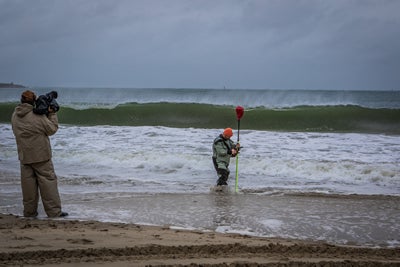Peter August, Chair, Napatree Science Advisors; Professor of Natural Resources Science, University of Rhode Island; and Senior Fellow, Coastal Institute
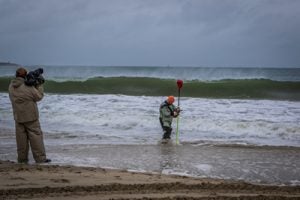 The weather was cold, rainy, and windy. Hurricane Joaquin was quickly closing in on New England, as evidenced by large surf pounding the beach at Napatree Point Conservation Area with the north winds shearing off the wave tops. It was perfect!
The weather was cold, rainy, and windy. Hurricane Joaquin was quickly closing in on New England, as evidenced by large surf pounding the beach at Napatree Point Conservation Area with the north winds shearing off the wave tops. It was perfect!
And, in defiance of Mother Nature, a group of stalwart scientists and filmmakers braved the elements to document coastal geology and migratory birds to share with a national audience.
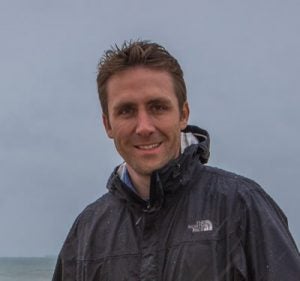 Philippe Cousteau, Jr., grandson of pioneer oceanographer Jacques-Yves Cousteau, is the host of Xploration Awesome Planet, a nationally-syndicated television show geared toward teenagers and focused on nature and the environment. Cousteau and a production team spent a stormy day on Napatree Point in Watch Hill, Rhode Island, on October 2nd to interview, film, and capture the research of URI scientists and alumni.
Philippe Cousteau, Jr., grandson of pioneer oceanographer Jacques-Yves Cousteau, is the host of Xploration Awesome Planet, a nationally-syndicated television show geared toward teenagers and focused on nature and the environment. Cousteau and a production team spent a stormy day on Napatree Point in Watch Hill, Rhode Island, on October 2nd to interview, film, and capture the research of URI scientists and alumni.
How did Cousteau–a nationally recognized television host, ocean advocate, and philanthropist–end up on Rhode Island shores with URI researchers? It was a perfect storm of communication, collaboration, and being able to quickly mobilize researchers investigating compelling and applicable questions.
The Coastal Institute was contacted by the producer of Awesome Planet asking about interesting filming venues in Rhode Island. The Coastal Institute immediately thought of Napatree Point a Coastal Institute Demonstration Site for promoting natural resilience in light of intensifying climate change and a hotbed of scientific monitoring and interdisciplinary research.
The producer enthusiastically committed to filming coastal geologist Dr. Bryan Oakley and migratory bird ecologists Dr. Peter Paton and Ms. Pamela Loring.
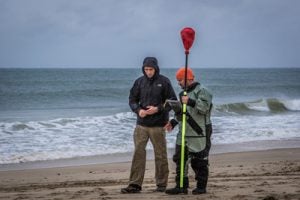 Cousteau and Oakley walked the beach in their foul weather gear, backs to the gusts of strong wind, as Oakley conducted his barrier beach profile monitoring. Dr. Oakley explained to Cousteau and his television audience that monitoring the beach before and after major storms allows him to track the natural migration of the dune sand from the ocean side of Napatree Point toward Little Narragansett Bay, and figure out how long it takes beaches to recover from storms. Oakley has chosen Napatree Point for his long-term studies because it is one of the most pristine barrier beach systems in the region.
Cousteau and Oakley walked the beach in their foul weather gear, backs to the gusts of strong wind, as Oakley conducted his barrier beach profile monitoring. Dr. Oakley explained to Cousteau and his television audience that monitoring the beach before and after major storms allows him to track the natural migration of the dune sand from the ocean side of Napatree Point toward Little Narragansett Bay, and figure out how long it takes beaches to recover from storms. Oakley has chosen Napatree Point for his long-term studies because it is one of the most pristine barrier beach systems in the region.
As the rain pelted down harder and the temperature continued to drop, Cousteau then asked Peter Paton and Pam Loring about the shorebirds that were gracefully flying through the storm. Paton and Loring led Cousteau to a 40-foot high radio antenna that is part of a system that stretches throughout the region. They discussed the importance of the current study that tags migratory shorebirds with extremely small transmitters, or nanotags, and then tracks the tagged birds that fly past the antenna as they migrate along the New England coast. This research then informs decisions guiding offshore wind turbine development to ensure that future wind farms are not sited in important shorebird 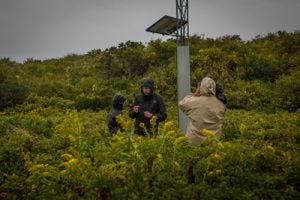 flyways.
flyways.
The weather may have been cold, rainy, and windy, but it was the perfect backdrop to Oakley’s mantra that barrier beach systems are storm-driven and. Loring’s message that fall storms help push birds south on their annual migrations.
Cousteau and Awesome Planet offered a unique opportunity to shine a national spotlight on Napatree Point and the University of Rhode Island. But, what will not make an appearance on screen is the fantastic support from Napatree Point partners who quickly worked to make the event possible.
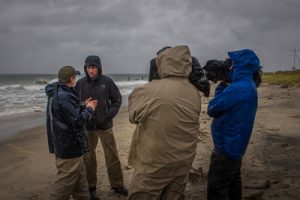 Janice Sassi and Grant Simmons of the Napatree Point Conservation Area hosted the day’s filming. They were not only gracious hosts for Cousteau and the Awesome Planet team, but they are strong partners of the University of Rhode Island and support a wide range of research from the Rhode Island Natural History Surveys’s planting of native plants on the dunes to examining fish diversity in the Napatree lagoon. Awesome Planet could only highlight a small portion of the important and useful research conducted at Napatree Point that is guided by and supported by Sassi, Simmons, and the science advisory team.
Janice Sassi and Grant Simmons of the Napatree Point Conservation Area hosted the day’s filming. They were not only gracious hosts for Cousteau and the Awesome Planet team, but they are strong partners of the University of Rhode Island and support a wide range of research from the Rhode Island Natural History Surveys’s planting of native plants on the dunes to examining fish diversity in the Napatree lagoon. Awesome Planet could only highlight a small portion of the important and useful research conducted at Napatree Point that is guided by and supported by Sassi, Simmons, and the science advisory team.
The Coastal Institute at URI has been a collaborator on a number of projects at the Napatree Point Conservation Area over the past several years. 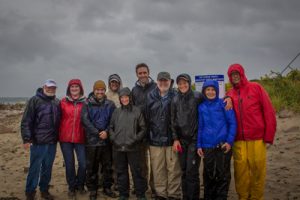 Coastal Institute Leveraging Grants support several research projects that then contribute to and strengthen future grant applications.
Coastal Institute Leveraging Grants support several research projects that then contribute to and strengthen future grant applications.
Despite the drenching everyone took, it was a wonderful setting for the stories the scientists told. Thanks to the enthusiasm by all of the partners and the interest by Cousteau and Awesome Planet, kids across the country will be discover a fascinating array of science questions driving research as they are introduced to Napatree Point from the comfort of home.. Perhaps the stories will even inspire the next generation of coastal researchers or environmental science communicators.
Participants for the day:
Philippe Cousteau, Jr.– host, Xploration Awesome Planet
Jason Evans–producer, Xploration Awesome Planet
Stephen Sullivan –camera, Xploration Awesome Planet
Bryan Oakley–assistant professor, Eastern Connecticut State University; University of Rhode Island alumnus.
Peter Paton–professor, Natural Resources Science, CELS, University of Rhode Island
Pamela Loring–PhD candidate, University of Massachusetts-Amherst; University of Rhode Island alumna
Brett Still–PhD candidate, University of Rhode Island
Grant Simmons III–Parks Commissioner, Watch Hill Fire District
Janice Sassi–manager, Napatree Point Conservation Area, Watch Hill Conservancy/Watch Hill Fire District
Peter August–professor, Natural Resources Science, CELS, University of Rhode Island; chair, Napatree Point Conservation Area Science Advisory Team
Judith Swift–director, Coastal Institute at the University of Rhode Island
Nicole Rohr–assistant director, Coastal Institute at the University of Rhode Island
Ayla Fox–photographer, Shed Light Productions, LLC and University of Rhode Island alumna
Todd McLeish–communications and marketing specialist, University of Rhode Island
Beach survey research supported by:
Eastern Connecticut State University Exemplary Program Funds
Rhode Island Shoreline Change Special Area Management Plan, CRMC
Rhode Island Bays Rivers Coordination Team
Migratory bird research supported by:
University of Massachusetts-Amherst
Bureau of Ocean Energy Management
U.S. Fish and Wildlife Service
Additional Napatree research supported by:
Rhode Island Natural History Survey
The Quebec-Labrador Foundation, Sounds Conservancy Grant Program
Watch Hill Fire District
Watch Hill Conservancy
Rhode Island Coastal Resources Management Council
RI Department of Environmental Management
NOAA Restoration Center
Save The Bay
RhodyNative
Conservation Stewardship Collaborative
U.S. Fish and Wildlife Service
U.S. Department of Agriculture Natural Resources Conservation Service
Sacred Heart University
The Nature Conservancy
Audubon Society of RI
Photos credit: Ayla Fox, the Coastal Institute at the University of Rhode Island

